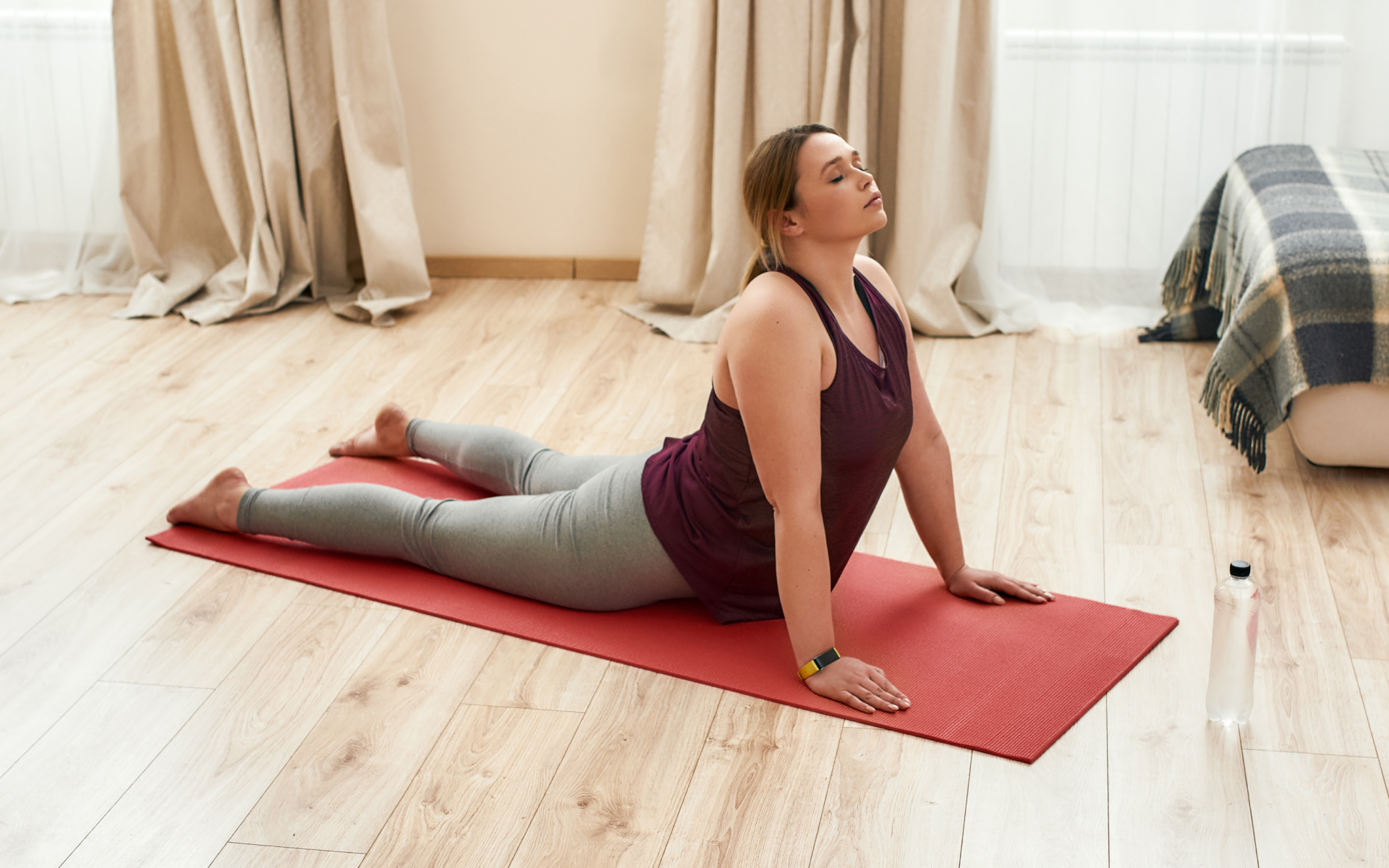When a traumatic event occurs, our bodies don’t always know how to process the experience. Emotions get embedded deep within us, often manifesting as physical discomfort or pain known as somatization. Here is where somatic therapy exercises come in.
Somatic therapy is a body-centered approach that bridges the gap between the mind and the body, helping individuals release stored tension, access physical sensations and be more attuned to their body (2). It greatly complements cognitive therapy, which mostly works with the mind.
This guide aims to explore these transformative exercises, shedding light on how they can help you navigate through your emotions related to the traumatic experiences, promoting healing and resilience.
We should caution you—somatic therapy exercises can be intense and uncomfortable, but they are also powerful tools that can help you work through your emotions. Before you start practicing them, it is important to remember two things:
- Take care of yourself: It’s ok if some exercises feel too strenuous—listen to your body, and pause when needed and return to it once you are comfortable.
- Practice with an open heart: Be compassionate and understanding of your emotions—allow yourself to feel whatever comes up.
- Seek Professional Support: if these feelings or emotions are significantly impacting your well-being, it may be helpful to seek guidance from a qualified somatic therapist or mental health professional for personalized guidance and interventions.
Now, let’s get started!
What Is Somatic Therapy Best For?
Somatic therapy is a therapeutic approach that combines traditional talk therapy techniques with physical therapeutic interventions. It’s built on the understanding that mind and body are not separate entities, but rather interconnected aspects of our overall health and wellbeing.
This form of therapy believes that our bodies hold onto past traumas in the form of sensations, emotions, or tensed muscles. All these are reflected in our body language, posture, and expressions.
Through developing awareness of our bodily sensations and movements, somatic therapy helps us release tension, reduce discomfort, and make significant emotional shifts.
If you’ve dipped your toes in meditation before but couldn’t sit through a session because of all the thoughts buzzing in your head, impulses snatching away control or all the overwhelming feelings that start bubbling up the minute you sink into the silence, it’s only because you didn’t have the right guidance. Start using BetterMe: Meditation & Sleep app and watch your life transform!
Trauma Recovery
Somatic therapy is particularly effective in helping individuals reprocess and recover from trauma.
Experiencing traumatic events can leave a lasting impact, causing the body to stay in a state of high alert as a protective measure. This can result in feelings of anxiety, fear, and hyper-awareness of danger (5).
Somatic therapy helps individuals recognize these physical responses to trauma, providing tools to alleviate these symptoms. By focusing on the physical manifestations of trauma, individuals are able to release stored tension, leading to a reduction in trauma-related symptoms (5).
In addition, somatic therapy offers a gentle approach to trauma recovery.
Unlike other forms of therapy, Somatic therapy is not meant to directly evoke traumatic memories, it focuses on body sensations, allowing for a more gradual and less confronting healing process. This makes it a suitable choice for those who may struggle with more direct approaches to trauma recovery.
Stress Relief
In today’s fast-paced world, stress has become a common issue affecting many people.Stress is a normal reaction to everyday pressures, but can become unhealthy when it upsets your day-to-day functioning.
Critical/chronic stress is created by situations where individuals are unable to meet the demands upon them and suffer a physical or psychological breakdown. Chronic stress can lead to numerous health problems, including heart disease, diabetes, and mental health disorders (4).
Somatic therapy provides an effective way to cope with stress. By becoming more aware of how our bodies respond to stress, we can learn to regulate these physical responses, reducing the negative impact of stress on our health.
Somatic therapy exercises, such as deep breathing, mindfulness, and movement, can help calm the nervous system, promoting relaxation and stress relief.
Regular practice of these techniques can lead to long-term improvements in managing stress, contributing to overall mental and physical wellbeing.
Improved Mind-Body Connection
Somatic therapy is all about enhancing the mind-body connection.
It encourages individuals to tune into their bodies, recognize cues of discomfort and respond to them in an appropriate way. This heightened internal awareness of your body can lead to improved mental health, as individuals become better equipped to recognize and manage emotional distress. On the long term, this means that the body will store less stress and tension, since these are addressed and managed as they appear.
Furthermore, by strengthening one’s ability to regulate emotions and establishing a stronger mind-body connection, somatic therapy can lead to enhanced self-care practices.
As individuals become more in tune with their bodies, they may be more likely to engage in healthy behaviors, such as regular exercise, healthy eating, and adequate sleep, further promoting overall wellbeing.
Emotional Release
Often, our bodies store emotional pain, with these emotions manifesting as physical symptoms, such as muscle tension or stomachaches.
Somatic therapy provides a pathway for working with these stored emotions. Through various techniques, individuals are guided to physically identify the emotional tension, which leads the nervous system to engage in the behaviours needed to release it. Gradually, this will result in better emotional wellbeing (3).
Not only does this emotional release provide immediate relief from physical discomfort, but it also promotes long-term mental and physical health.
By learning to effectively release emotions, individuals can prevent the accumulation of emotional tension, reducing the likelihood of physical symptoms in the future.
Enhanced Self-Awareness
Somatic therapy promotes a deep sense of self-awareness.
As individuals become more aware of their physical responses to emotional distress, they gain a deeper understanding of their emotional landscape. This heightened self-awareness can lead to improved emotional regulation, as individuals become better equipped to recognize and manage emotional distress.
Moreover, this enhanced self-awareness extends beyond the therapy session.
The skills learned in somatic therapy can be applied in everyday life, helping individuals navigate challenging situations with greater ease. For example, they will be able to identify when they are in a state of dysregulation and overwhelm and practice stronger boundaries or take on less work. This can lead to improved relationships, better performance at work or school, and a higher overall quality of life.
Read more: Somatic Release: Unlock the Power of Mind-Body Connection.
What Are The Examples of Somatic Therapy Exercises?
Somatic therapy exercises encompass a wide range of techniques that are designed to help individuals reconnect with their bodies, release stored tension, and enhance their overall wellbeing.
These exercises focus on body awareness, movement, and mindful reflection, helping individuals to tune into their physical experiences and develop personal movement styles. Let’s take a look at a few examples of these transformative exercises.
Standing Awareness
Standing awareness is a straightforward yet effective somatic exercise that promotes body mindfulness. This exercise involves standing firmly on the ground and tuning into the various sensations in your body.
Steps for executing standing awareness:
- Stand up straight with your feet rooted into the ground.
- Don’t try to have perfect posture, relax as much as you can
- Notice how your feet are in contact with the floor. Let your arms hang by your sides, and close your eyes.
- Pay attention to how your stomach moves slightly as you breathe in and out.
- Scan your body for any tension, observing without judgment.
- Articulate how you’re feeling as you go
Diaphragmatic Breathing
Diaphragmatic breathing or belly breathing, is a type of deep breathing where you consciously engage your diaphragm to inhale and exhale. This technique is commonly used in yoga, meditation, and stress management because it helps to slow down your breathing rate and take in more oxygen, which can promote relaxation and reduce stress.
Here’s how you do it:
- Lie down or sit comfortably.
- Place one hand on your chest and the other on your belly.
- Take a slow, deep breath in through your nose, allowing your belly to push up against your hand. Your chest should not move.
- Exhale through your mouth, pushing out as much air as you can while contracting your abdominal muscles. The hand on your belly should move down to its original position.
- Repeat these steps 3 to 10 times.
Somatic Dancing
Dance Movement Therapy includes somatic elements and should be conducted under the supervision of a trained therapists.
Somatic dancing involves using movement and dance as a form of emotional release. This type of exercise can be particularly beneficial for those who find verbal expression challenging.
Body Scanning
Body scanning is a mindfulness-based somatic exercise that involves mentally scanning each part of the body to identify areas of tension or discomfort.
Steps for executing body scanning:
- Lie down in a comfortable position and close your eyes.
- Starting from your toes, slowly scan down your body, paying attention to each part in turn.
- Notice any areas of tension, discomfort, or other sensations, observing without judgment.
- Spend a few moments focusing on each area and when you feel any tension, breathe deeply and exhale into it and allow the area to relax.
- When you feel the body part relax, you can move to the next one.
- Continue this process, until you reach your head..
Progressive Muscle Relaxation (PMR)
Progressive muscle relaxation involves consciously tensing and then releasing different muscle groups. This exercise can help to release physical tension and promote relaxation.
Steps for executing progressive muscle relaxation:
- Find a comfortable seated or lying position.
- Starting with your toes, tense the muscles as tightly as you can for a count of five.
- Slowly release the tension, noticing the feeling of relaxation that follows.
- Continue this process with each muscle group in your body, working your way up from your toes to your head.
Grounding Exercise
Grounding is a simple yet powerful technique used in somatic therapy to help individuals stay present and connected with their physical environment.
Steps for executing grounding exercise:
- Stand or sit comfortably.
- Begin by running cold water over your hands.
- Pay attention to the sensation of the water on your skin. Allow your awareness to center on the delicate sensation of the water’s temperature caressing your palms, fingertips, and the back of your hands.
- Change the temperature of the water to warm and notice the sensations as the water flows on both sides of your hands.
- Repeat this process as you wish.
The 5-4-3-2-1 Method
The 5-4-3-2-1 grounding technique is a common strategy, it can help you regain control of your mind when they are feeling anxious, stressed, or overwhelmed. It uses the five senses to ground you in the present and distract from distressing thoughts or feelings.
Here’s how to do it:
- Five (5) – Look: Identify five things that you can see around you. It could be a pen, a spot on the ceiling, anything in your surroundings.
- Four (4) – Feel: Identify four things you can touch or feel. It could be the texture of your jeans, the feeling of the breeze on your skin, or the surface of a table near you.
- Three (3) – Hear: Acknowledge three things you can hear. This could be the sound of traffic outside, the ticking of a clock, or the hum of the refrigerator.
- Two (2) – Smell: Recognize two things you can smell. If you can’t immediately smell two things from where you are, it’s perfectly okay to move around or even recall your favorite smells.
- One (1) – Taste: Recognize one thing you can taste. It may be the aftertaste of a meal, or you could take a sip of a drink, chew a piece of gum, or eat something.
BetterMe: Meditation & Sleep app can help you transmute stress into serenity, pull you up from the doldrums, free your mind from the cares and worries of the world, quell racing thoughts and infuse you with tranquility! Start using it now and change your life!
What Are The Negative Effects of Somatic Therapy?
While somatic therapy is often effective in treating trauma-related disorders and stress-related conditions, like any therapeutic approach, it’s not without potential negative effects. These adverse reactions are typically a result of the intense emotional and physical work involved in this form of therapy.
One concern is the possibility of becoming dependent on the therapist.
The close, supportive relationship between the client and therapist can sometimes lead to an over-reliance on the therapist for emotional stability. This dependency can hinder the individual’s progress towards self-regulation and autonomy (1).
However, a trained therapist will guide you to learn self-regulation and improve your own coping skills.
Another potential negative effect involves feelings of distress after therapy sessions. Mindfulness based stress reduction, for example, which uses elements of somatic therapy often involves revisiting and processing traumatic experiences. This can lead to temporary increases in distress, including feelings of sadness, anxiety, or agitation (1).
In some cases, individuals might find the techniques used in somatic therapy uncomfortable or unsettling, and may feel overwhelmed by emotions that are released during a somatic exercise. This can happen if the exercise is not managed or paced properly. For example, diving too early into a traumatic memory in the therapeutic process without the client being able to self-regulate can lead them to feel overwhelmed by the experience. However, a good therapist will ensure that trauma processing is only done when the client is ready and has enough resources to access safety in their bodies.
Further, the focus on bringing out trauma can sometimes feel unsafe for individuals, particularly if they haven’t yet developed robust coping mechanisms. It could potentially retraumatize individuals if not handled with appropriate care and sensitivity.
Lastly, individuals who treat highly traumatized or dysregulated clients – such as therapists themselves – are at higher risk of developing symptoms of burnout and compassion fatigue.
It’s important to note that while these potential negative effects can occur, they are not inevitable.
A skilled and experienced therapist will be able to guide individuals safely through the process, ensuring that they feel supported and secure throughout their therapy journey. Moreover, for many people, the benefits of somatic therapy far outweigh these potential drawbacks.
How Do I Start Somatic Therapy?
Starting somatic therapy involves several steps, which include understanding what it entails, finding a suitable therapist, and preparing for your first session. Here’s a comprehensive guide on how to get started:
Understanding Somatic Therapy
Before you begin, it’s crucial to understand what somatic therapy is and its potential benefits and drawbacks.
This form of therapy focuses on the connection between mind and body, using physical techniques such as deep breathing, movement, and body awareness exercises to help release stored emotions that are linked to experiencing a traumatic event.
It’s beneficial for a wide range of mental and physical health issues, including trauma, stress, anxiety, depression, and more (3).
Finding a Therapist
Once you have a basic understanding of somatic therapy, the next step is to find a suitable therapist.
You’ll want someone who is not only trained in somatic therapy but also someone you feel comfortable with. You can start by searching online for somatic therapists in your area or asking for recommendations from healthcare professionals, friends, or family.
When choosing a therapist, consider factors like their qualifications, experience, approach to therapy, and any specialties they may have. It’s also essential to consider practical aspects like location, availability, cost, and whether they accept your insurance.
Initial Consultation
Most therapists offer an initial consultation, either free or at a reduced rate. This is an opportunity for you to meet the therapist, ask questions, and discuss your goals for therapy. It’s also a chance for the therapist to assess your needs and determine whether somatic therapy is a suitable approach for you.
Preparing for Your First Session
Before your first session it might be helpful to spend some time reflecting on what you hope to achieve through therapy. Consider any specific issues you’d like to work on, such as reducing anxiety, healing from experiencing a distressing event, or improving your mind-body connection.
During the session, be prepared to discuss your physical and emotional health, past experiences, and any current issues you’re facing. Remember, therapy is a safe space, and everything you share will be kept confidential.
Engaging in the Process
Somatic therapy is an active process that requires your participation both during sessions and in between.
Your therapist might give you exercises to do at home, such as deep breathing, mindful movement, or body scanning. Regularly practicing these exercises can enhance the effectiveness of your therapy.
Remember, starting therapy can bring up uncomfortable emotions, but this is a normal part of the healing process. Be patient with yourself, and don’t hesitate to communicate with your therapist about any concerns or difficulties you’re experiencing.
Read more: 10 Somatic Exercises To Release Pent-Up Emotions.
The Bottom Line
This guide to somatic therapy exercises offers valuable insights into how you can leverage the power of mind-body connection to overcome traumatic emotions. With easy-to-follow steps for various exercises, let it be your go-to resource for fostering emotional healing and resilience in 2023.
DISCLAIMER:
This article is intended for general informational purposes only and does not serve to address individual circumstances. It is not a substitute for professional advice or help and should not be relied on for making any kind of decision-making. Any action taken as a direct or indirect result of the information in this article is entirely at your own risk and is your sole responsibility.
BetterMe, its content staff, and its medical advisors accept no responsibility for inaccuracies, errors, misstatements, inconsistencies, or omissions and specifically disclaim any liability, loss or risk, personal, professional or otherwise, which may be incurred as a consequence, directly or indirectly, of the use and/or application of any content.
You should always seek the advice of your physician or other qualified health provider with any questions you may have regarding a medical condition or your specific situation. Never disregard professional medical advice or delay seeking it because of BetterMe content. If you suspect or think you may have a medical emergency, call your doctor.
SOURCES:
- Is psychotherapy for functional somatic syndromes harmful? A mixed methods study on negative effects (2017, pubmed.gov)
- Somatic Experiencing for Posttraumatic Stress Disorder: A Randomized Controlled Outcome Study (2017, nih.gov)
- Somatic experiencing – effectiveness and key factors of a body-oriented trauma therapy: a scoping literature review (2021, nih.gov)
- The effects of chronic stress on health: new insights into the molecular mechanisms of brain–body communication (2015, nih.gov)
- Understanding the Impact of Trauma (n.d., nih.gov)












